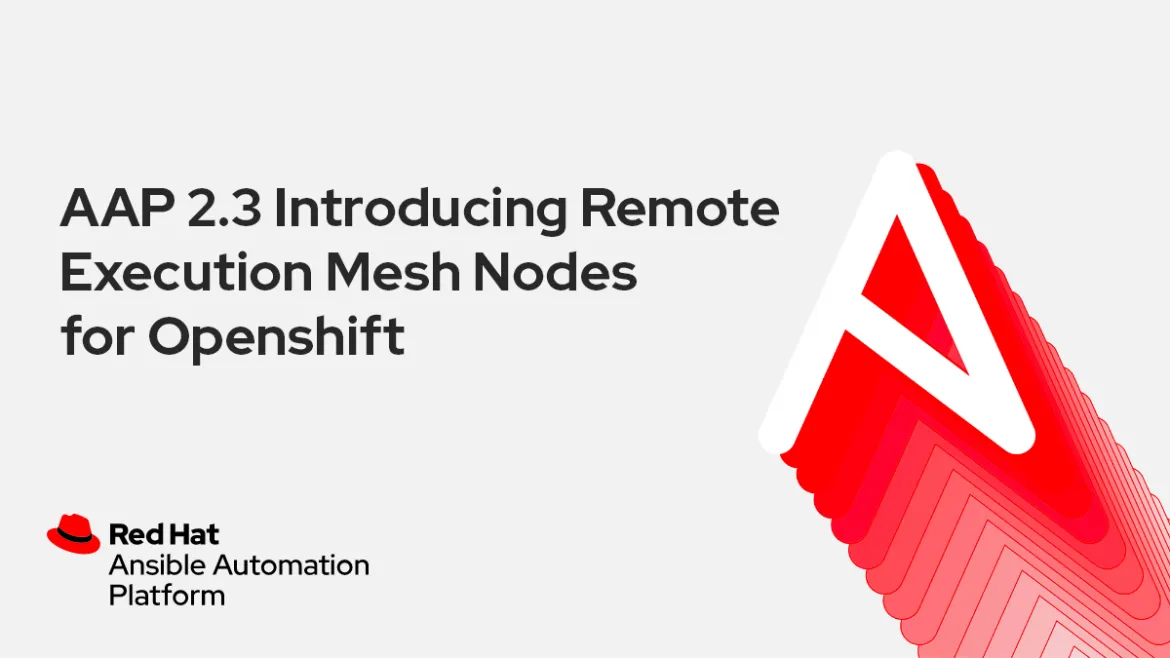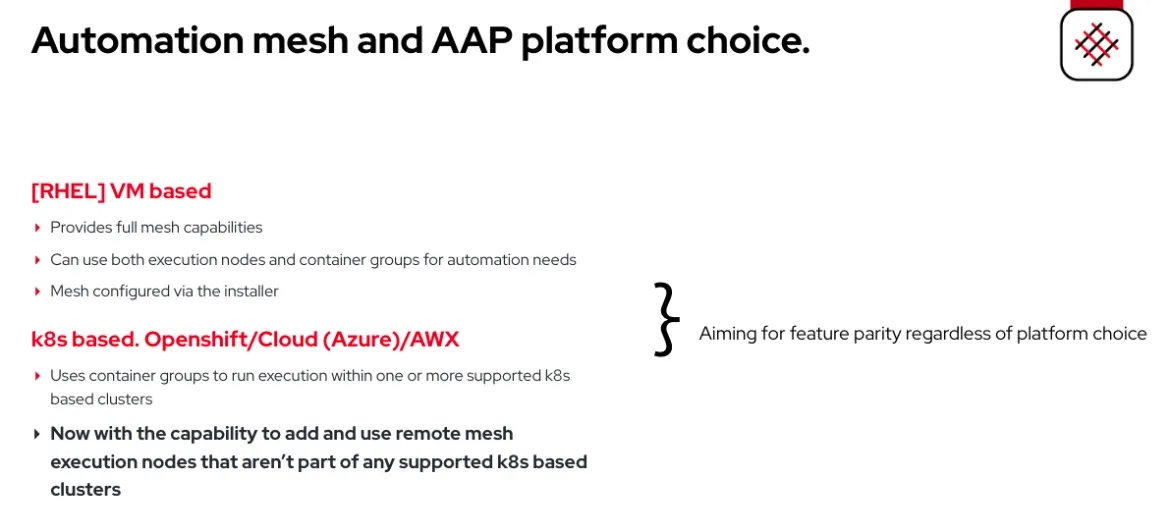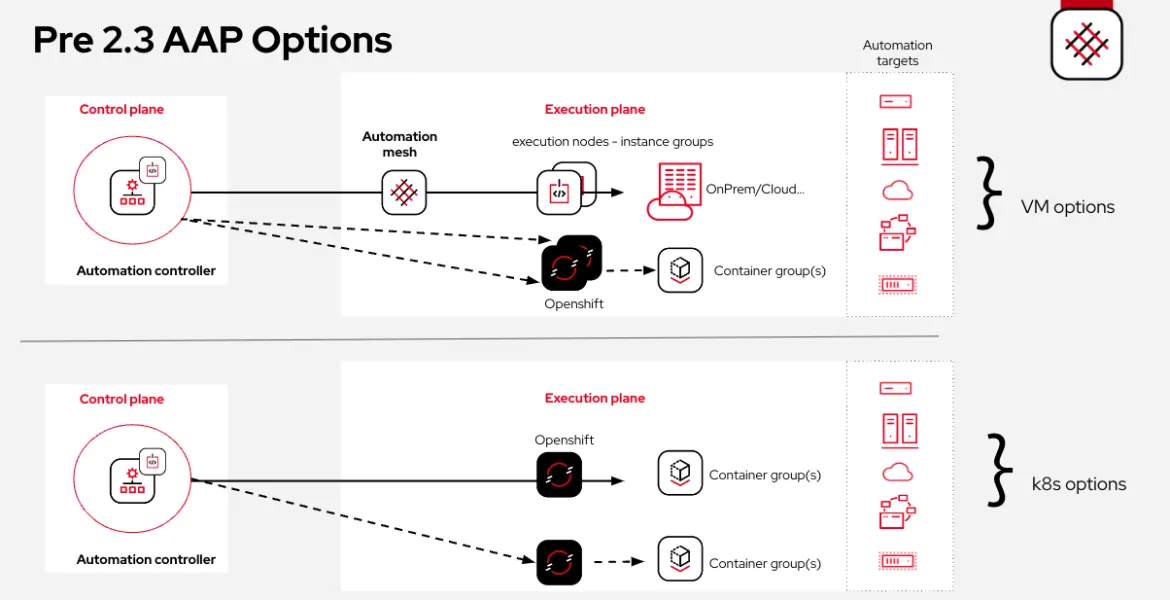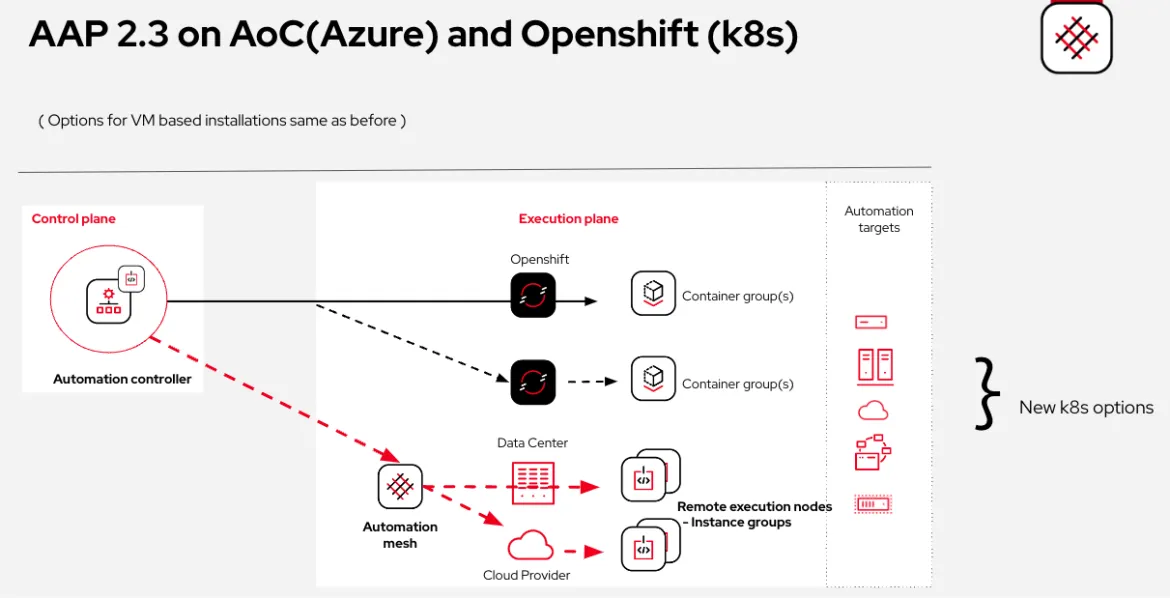
Last year Ansible Automation Platform (AAP) 2 introduced major changes around the mechanics on how automation is run. The main focus was to enhance the foundational pieces of the platform while providing flexibility and simplicity for automators to automate at enterprise scale. One of those foundational pieces introduced was automation mesh.
Automation mesh provides a simple, flexible and reliable way to scale automation of large inventories across diverse network topologies, platforms and teams. It was important to evolve how the platform was developed, managed, operated to meet business demands and needs, for the large majority of customers.
Pre 2.3 Automation Mesh in OCP
Prior to AAP 2.3, the automation mesh was mostly a VM deployment base option and feature. I’ve tried to highlight the main differences between platform choices in this diagram:

We are now starting to level up the feature parity, and this brings remote mesh execution nodes to non-VM supported deployments. Before we look more at the new feature, let’s look at the options that were available before:

For VM based deployments, the automation mesh introduced horizontal scaling, the ability to scale your automation needs out, whether locally or globally. We did this by installing execution and hop nodes where we needed them, to allow us to wrap new style automation around the existing instance group functionality.
For non-VM based deployments, such as those running on Red Hat OpenShift, you could only target automation using container groups, which made use of the Kubernetes API to create dynamic containers for runtime automation.
This was fine if that was all you needed, were all in on the kubernetes cloud native approach, but left a gap if you needed a more traditional, hybrid configuration, so allow you to run workloads in different locations or environments.
2.3 Automation Mesh in Red Hat OpenShift

In order to remove this limitation, in AAP 2.3 we have now released in Tech Preview, the ability to add remote mesh execution nodes. This is in addition to the use of the existing container groups.
NOTE: While we have added remote mesh execution nodes, hop nodes are not currently supported. We are working to add this further enhancement during a future release.
During AnsibleFest 2022, our very own controller lead engineer Hao Liu presented a virtual session around adding remote execution nodes when running AAP within a Red Hat OpenShift cluster. The virtual session is free and available on demand and includes more detailed content on how to successfully add remote execution nodes.
In summary
Red Hat Openshift now has the ability to use both container groups and remote execution nodes for automation, which:
- eases resources on the control plane (uwsgi, task manager).
- enables scaling beyond the cluster(s).
Integrate your Red Hat OpenShift AAP deployment with external execution nodes hosted anywhere/any environment:
- on premise data centers.
- cloud providers.
- edge deployments.
What can I do next?
Whether you are beginning your automation journey or a seasoned veteran, there are a variety of resources available to help you get the most out of your automation with Red Hat Ansible.
- If you’re looking for some additional context on the 2.3 release, you can register for our free webinar, “Ansible Automation Platform 2.3: Flexible, trusted automation at scale.”
- Watch the on-demand AnsibleFest 2022 session detailing the adding of remote execution nodes to an AAP on Red Hat OpenShift cluster
- Get hands on with on-demand self-paced exercises - We have a variety of interactive in-browser exercises that have been built to help you dive into directly Ansible Automation Platform.
- Trial subscription - Are you ready to install on-premises? Get your own trial subscription for unlimited access to all the components of Ansible Automation Platform.
- Developer license - Did you know that you can get a free developer license to learn in your home lab? Register and get access to all the latest tools, technologies and community that Red Hat has to offer.
- Subscribe to the Ansible Automation Platform YouTube channel.
- Follow Red Hat Ansible Automation Platform on Twitter - Do you have questions or an automation project you want to show off? Tweet at us!
저자 소개
Phil Griffiths is a Product Manager for Ansible Automation Platform with nearly seven years of experience at Red Hat. Phil has held roles as a solution architect and technical consultant both at Red Hat and for other organizations.
채널별 검색
오토메이션
기술, 팀, 인프라를 위한 IT 자동화 최신 동향
인공지능
고객이 어디서나 AI 워크로드를 실행할 수 있도록 지원하는 플랫폼 업데이트
오픈 하이브리드 클라우드
하이브리드 클라우드로 더욱 유연한 미래를 구축하는 방법을 알아보세요
보안
환경과 기술 전반에 걸쳐 리스크를 감소하는 방법에 대한 최신 정보
엣지 컴퓨팅
엣지에서의 운영을 단순화하는 플랫폼 업데이트
인프라
세계적으로 인정받은 기업용 Linux 플랫폼에 대한 최신 정보
애플리케이션
복잡한 애플리케이션에 대한 솔루션 더 보기
오리지널 쇼
엔터프라이즈 기술 분야의 제작자와 리더가 전하는 흥미로운 스토리
제품
- Red Hat Enterprise Linux
- Red Hat OpenShift Enterprise
- Red Hat Ansible Automation Platform
- 클라우드 서비스
- 모든 제품 보기
툴
체험, 구매 & 영업
커뮤니케이션
Red Hat 소개
Red Hat은 Linux, 클라우드, 컨테이너, 쿠버네티스 등을 포함한 글로벌 엔터프라이즈 오픈소스 솔루션 공급업체입니다. Red Hat은 코어 데이터센터에서 네트워크 엣지에 이르기까지 다양한 플랫폼과 환경에서 기업의 업무 편의성을 높여 주는 강화된 기능의 솔루션을 제공합니다.

